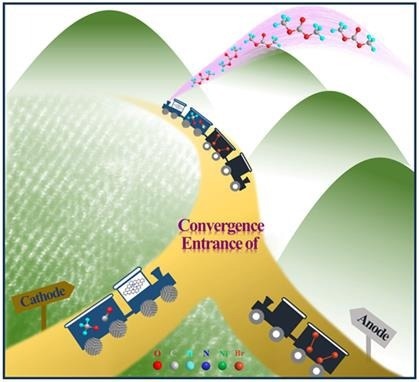The cathodic CO2 reduction reaction’s (CO2RR) byproducts are typically in reduced forms in a conventional electrochemical cell with a membrane separator. The anodic O2 development has no bearing on the ongoing expansion of the product range.
 Illustration of the Research. Image Credit: Prof. Zhu’s group.
Illustration of the Research. Image Credit: Prof. Zhu’s group.
Dimethyl carbonate (DMC, CH3OCOOCH3) is a chemical feedstock that is harmless to the environment. A significant shift in the manufacturing of DMC has been brought about by its convergent paired electrosynthesis.
A research team from the Fujian Institute of Research on the Structure of Matter of the Chinese Academy of Sciences, under the direction of Prof. Qilong Zhu, reported a Ni single-atom catalyst (Ni SAC) for CO2-to-CO conversion and the convergent paired electrosynthesis of DMC in a study published in Energy & Environmental Science.
The critical intermediates for the synthesis of DMC are formed by the convergent paired electrosynthesis, which the researchers discovered couples the anodic halide ion oxidation reaction with the cathodic CO2RR.
An enormous amount of work is put into controlling the micro-nanostructure of electrocatalysts during this conversion because the effective cathodic CO2-to-CO conversion plays such a prominent role.
They also demonstrated the controllable construction of the dual-channel super structure Ni SAC with a distinctive site coordination configuration bonded via one axial oxygen atom and four planar nitrogen atoms, demonstrating its ability to provide a preeminent performance for CO2-to-CO conversion, attaining the exclusively high Faradaic efficiency (FE) and partial current densities with good stability.
The convergent paired electrosynthesis of DMC from CO2 was first carried out, achieving the high FE of DMC, by virtue of the atomic to nano- to microscopic manipulation of the penta-coordinated Ni SAC for CO generation.
The mechanism analysis revealed that this arrangement of axial oxygen coordination aids in lowering the energy barriers for the production of the crucial *COOH intermediate and the dissociation of H2O and CH3OH, quickening the convergent paired electrosynthesis.
According to this study, the unique convergent paired electrosynthesis’s proof of concept might pave the way for new developments in the CO2 application domains.
Journal Reference:
Li, X., et al. (2023) Convergent paired electrosynthesis of dimethyl carbonate from carbon dioxide enabled by designing the superstructure of axial oxygen coordinated nickel single-atom catalysts. Energy & Environmental Science. doi:10.1039/D2EE03022E.